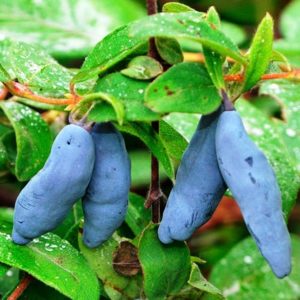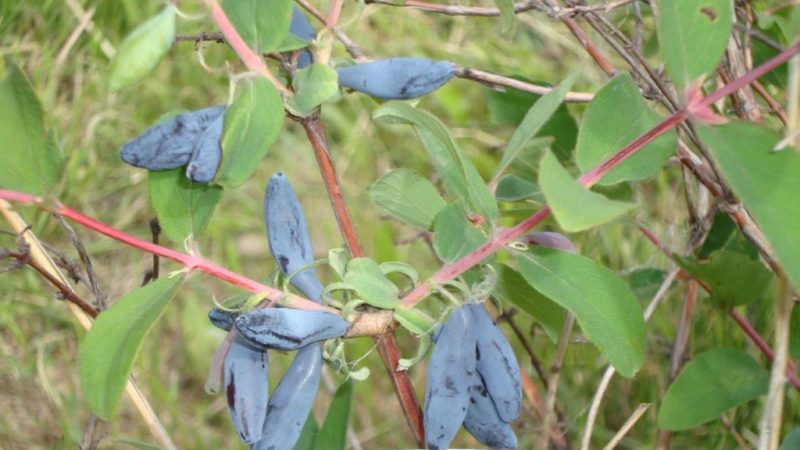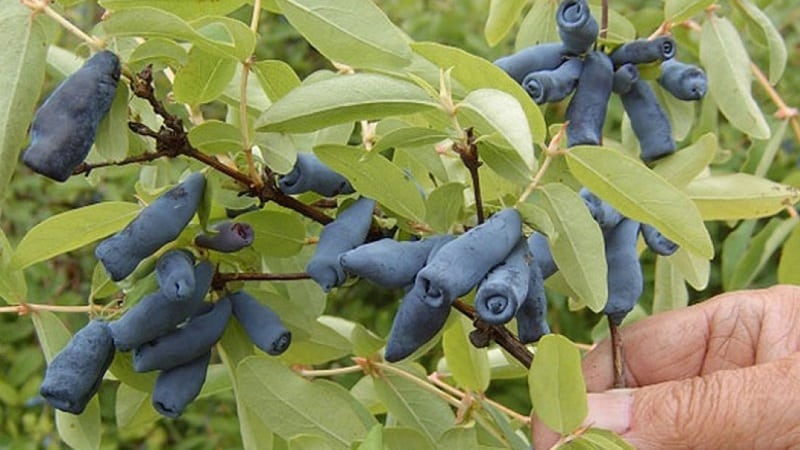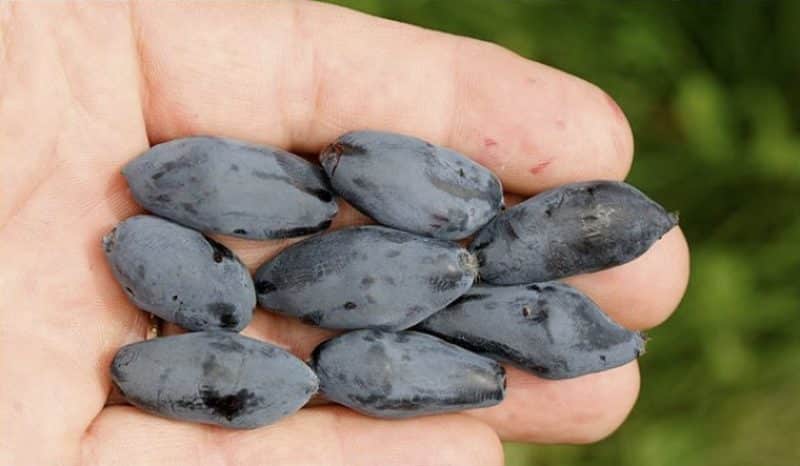The sweetest and largest varieties of honeysuckle for Siberia
Honeysuckle is one of the few berry crops that thrives in the harsh Siberian winter. The plant is frost-resistant, easy to care for, and bears fruit consistently. The fruit is harvested in August or September, the fruits are eaten fresh or stored for the winter: they are made into preserves and jams, dried and added to tea. Let's consider a description of the varieties of sweet and large honeysuckle for Siberia, their properties and characteristics.
Requirements for choosing a honeysuckle variety for Siberia

First of all, it is important to choose a seedling: not only future productivity depends on it, but also the plant’s resistance to low temperatures. Three-year-old specimens with elastic branches are suitable - there must be at least three of them. The root system is branched, with an abundance of small white roots.
Attention! The main requirement is frost resistance. Most released varieties can withstand temperatures down to -50°C.
Preferable varieties are resistant to diseases: white spot, powdery mildew, cercospora. The strong immunity of honeysuckle makes it easier caring for her, increases productivity. When choosing, pay attention to the ripening period and yield, taste and appearance of the fruit, purpose and care requirements.
A selection of large and sweet varieties for Siberia

Some varieties are ideal for processing, others for fresh consumption.
To choose a suitable plant, it is advisable to study the weight and shape of the fruit, color and taste, care requirements and cultivation characteristics.
Azure
A universal mid-season variety. The bushes are medium-sized, 1.5–2 m high, thin shoots, large leaves. The berries are elongated-oval, average weight - 1 g. The skin is durable, rich blue in color with a white-blue coating. The pulp is tender, the taste is sweet and sour, with a blueberry aftertaste, the aroma is pronounced. Tasting score: 4.5 points out of 5.
Lazurnaya ripens in June and is unpretentious in care. Productivity is from 1 to 2 kg, depending on the age of the bush. The variety is partially self-fertile, which increases productivity. One of the advantages is the weak shedding of berries after ripening.
Kingfisher
Mid-late dessert variety. The shoots are medium-sized, the crown is compressed, the leaves are matte green. The berries are blue, oval-round, with a thick tip. There is a faint blue coating and pubescence. The taste is sweet, without bitterness, pleasant. Rating: 4.8 points out of 5. Fruit weight: about 1.1 g.
The productivity of Kingfisher is up to 2 kg per bush per season. The skin of the berries is thin, so they are used fresh or processed = the crop is not suitable for transportation. The variety is winter-hardy and is rarely attacked by insects. Moderately resistant to drought and heat.
Siberian
Sibiryachka honeysuckle is harvested in June. The bushes are medium in size, the shoots are thin and elastic, the flowers are pale yellow. The weight of the berry is about 1 g, the color is blue-violet, with a blue bloom. The flesh is tender and elastic, the taste is sweet and sour. Taster rating: 4.9 points. A young bush produces about 0.5 kg of honeysuckle per season, an adult - from 3 to 4 kg.
Attention! In the third year after planting, honeysuckle is thinned out and shaped. Old branches are shortened by 20 cm.If this is not done regularly, the shrub will lose its decorative appearance and the yield will decrease. It is important to pay attention to the lower branches: they should be well lit. This is where most of the flowers are laid.
The Siberian rarely gets sick. Disadvantages include the fruits falling off, so they are harvested immediately after ripening.
My joy
Medium-growing, medium-late variety. The shape of the berries is round-oval, the color is blue-violet, there is a slight bloom. Weight - 1 g, some specimens reach 1.5 g. The taste is sweet, the flesh is tender and juicy, without bitterness or sourness. Tasting score: 4.6 points.
In the fourth year after planting, the yield reaches 2.3 kg per plant. Among the advantages of the variety are winter hardiness and low fruit shedding. The crop's tolerance to heat and drought is average.
Juices and compotes, tinctures and fruit and berry desserts are prepared from honeysuckle. The pleasant taste of berries goes harmoniously with ice cream, fresh baked goods, and refreshing drinks.
Volkhova
Mid-season variety for universal use. The shoots are thick and strong, light green in color. The height of the bush is up to 2 m. The berries are round-oval, with a sharp tip, the skin is medium thick. Weight - about 0.8 g, color blue-blue, with a white coating and slight pubescence. The taste is sweet, tasting score - 4.7 points out of 5.
The skin of the berries is strong, so the crop is used for transportation and storage. From 1.5 to 3 kg of fruits are harvested from a bush, depending on weather conditions and the age of the plant. The variety is frost-hardy, disease-resistant, slightly affected pests. Requires pollinators.
Nymph
A mid-early variety, unpretentious to grow, rarely damaged by insects. The height of the bush is about 1.5 m, the crown is spreading and round. The berries are large, the weight of one is from 1 to 3 g, the shape is elongated.The surface is slightly lumpy blue-blue. The skin is of medium thickness, the flesh is sweet and aromatic, without bitterness. Taste rating: 4.7 points.
The harvest ripens by mid-June, the shedding is weak. The variety is early-bearing - the fruits are harvested 3 years after planting. To increase productivity, it is recommended to plant Nymph on loamy soils.
Fire opal
The variety is mid-early and ripens at the end of June. The bushes are spreading, medium-sized, height - up to 1.7 m. The leaves are large, dark green. Berry weight - 1.2 g, oval shape, blue-black, rich color. The taste is sweet and sour, rating - 4.5 points.
Attention! Honeysuckle is planted in early autumn and early spring. The depth of the hole should be at least 1 m, the distance between the bushes should be at least 1.5 m.
The ripening period of Fire Opal is extended - the harvest is harvested several times per season. The bush bears fruit 3 years after planting. Resistance to diseases and frost is high, the berries are universally used.
Moraine
Mid-early dessert variety. The bushes are vigorous, the shoots are long brown-green. The berries are one-dimensional, elongated, weight - about 1 g. The color is blue-blue. The taste is without bitterness, sweet and sour. The pulp is tender and pleasant, aromatic. Tasting score: 4.5 points.
Ripening occurs at the end of June or beginning of July. Productivity is about 1.5 kg of honeysuckle per season. Moraine is self-sterile, so varieties are planted nearby Blue spindle, Bluebird or Viola.

Berel
Early ripening honeysuckle Berel is resistant to shedding. The bushes are medium-sized, the crown is small. The weight of the berry is from 0.5 to 1 g, the shape is conical. The color is blue-black, rich, with a bluish tint. The taste is sweet and sour, balanced. The variety is early-bearing - the first harvest appears 2-3 years after planting.
The advantages include transportability and stable yield: every year summer residents collect up to 3 kg of berries from a bush. Ripe fruits are universal in use: they are used for processing, sale, and fresh consumption.
Early varieties of honeysuckle for Siberia

Early varieties are most often used in cooking: the berries are preserved in jars, ground with sugar, and jams and juices are made from them. The fruits ripen in mid-June; the plants are distinguished by strong immunity and ease of cultivation.
Important! Most early varieties are not suitable for long-term harvest storage and transportation.
One of the popular early ripening varieties is Gerda honeysuckle. Partially self-fertile, universal in use. The bushes are spreading, height - 1.5 m. The shoots are straight and matte, the leaves are green. The weight of the berry is about 0.7 g, the color is blue-black, with a blue coating, the shape is oval. The taste is sweet and sour, pleasant, the pulp is medium dense. The first berries appear on the bush 2 years after planting. Productivity is about 2 kg per plant per season. They use not only berries, but also leaves: vitamin herbal tea is brewed from them.
Siberian summer residents also choose Narym honeysuckle for planting. The bushes are compact and take up little space on the site. The weight of the berry is up to 1 g, the shape is oval-round, slightly elongated. The peel is medium thick, blue-violet in color, with a blue tinge. The taste is sweet and sour, tasting score - 4.8 points out of 5. Narymskaya frost-resistant, rarely more viral and fungal diseases.
Late

Late honeysuckle is used for storage and transportation and is grown on an industrial scale. The berries have a thick skin that protects them from cracking and spoilage.
One of the best late varieties is Provincialka.The bushes are weak-growing, the shoots are curved. The berries are large: the weight of one reaches 1.9 g. The shape is oval, the skin is dark blue, with a coating. The pulp is sweet and juicy, the taste is pleasant berry, tasting score - 5 points. The bushes are unpretentious in cultivation, resistant to drought, diseases and pests, and bear fruit consistently.
Another late-ripening variety is Selena. The height of the bush is 1.7 m, the crown is compressed. The weight of the fruit is up to 1 g, the shape is elliptical, the color is blue-black, with a blue bloom. The taste is sweet and sour, with a slight bitterness. Honeysuckle ripens in the second half of June, rarely gets sick, and does not fall off. The pulp has a pleasant taste and contains vitamins C (18 mg/%) and P (1829 mg/%).
Edible varieties

Honeysuckle is divided into edible and decorative. The first is grown for practical purposes: for food or processing, the second - for decorating a summer cottage or creating a hedge.
The following edible varieties are popular:
- Velvet. A vigorous bush with straight shoots. The berries are oval, dark blue, weigh about 1 g. The taste is delicate, sweet and sour, with a slight bitterness. The variety is winter-hardy and is not damaged by insects and diseases.
- Bakchar giant. Mid-season variety with extended fruiting. The berries are large, weigh up to 1.8 g. The skin is blue, with a waxy coating, the taste is sweet and sour, pleasant. The tasting score of the Bakchar giant is 4.8 points.
- Yugana. A universal mid-season variety. The weight of the fruit is 1.2–1.8 g, the shape is pitcher-shaped, the color is blue, with a bloom, the peel is thick. The taste is sweet and juicy, the aroma is pleasant and refreshing. Taster rating: 4.8 points. Yugana is resistant to frost and drought, and is weakly affected by pests.
Decorative
Decorative honeysuckle decorates the garden with a lush and green crown, original inflorescences, and attractive fruits.
Plants are frost-resistant and do not require much attention:
- Nikolushka. The height of the plant is up to 3 m, the crown is pyramidal-spreading, curved shoots grow downwards. The flowers are original, white-cherry variegated color. The buds are white-green, with a crimson tint. Nikolushka blooms in mid-May. A winter-hardy and heat-resistant variety is used to create hedges.
- In memory of Skvortsov. The height of the bush is 2.5 m, the fruits are round, red, and do not fall off. The flowers are white with a bright pink spot, the peduncle is crimson, the anthers are a rich yellow color. The buds bloom quickly. Honeysuckle is used for landscaping and garden decoration.
- Golden. A separate type of honeysuckle. The spreading shrub blooms in late May-June. The leaves are dark green, the flowers are golden, and have a rich sweet aroma. The berries are red, round, diameter up to 8 mm. The golden one does not get sick, is easy to care for, and gets prettier every year.
How to choose the right variety

Decorative varieties are chosen to decorate the garden: colorful berries and flowers look attractive in any area. For fresh consumption, plant early edible varieties with thin peel, late for storage and transportation.
Those who love a tart taste will like plants with bitter berry pulp, while others will like sweet and sour-sweet ones. These and other characteristics are clarified by the seedling seller. It is important to pay attention to the timing landings and ripening, find out whether the plant often gets sick or not.
Conclusion
Sibiryachka, Kingfisher, Volkhova - varieties with large and sweet berries for Siberia. They are frost-resistant, rarely get sick, and are resistant to insect pests. Of the early varieties, Gerda or Narymskaya are distinguished, and of the later varieties, Provincialka or Selena.To decorate a summer cottage, seedlings of Zolotistaya or Nikolushka are bought. Ripe fruits are used to prepare winter preparations: honeysuckle is considered one of the healthiest berries.